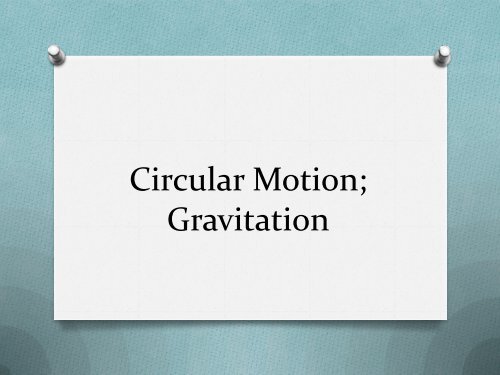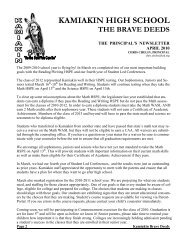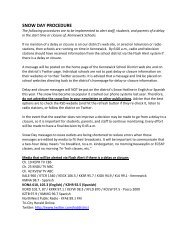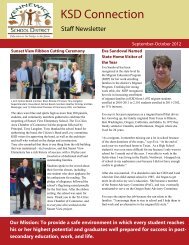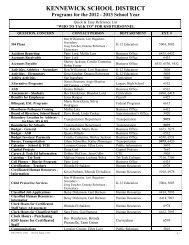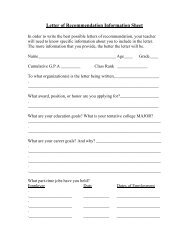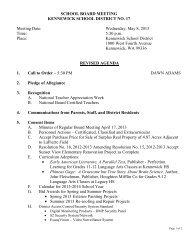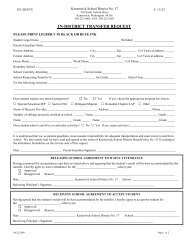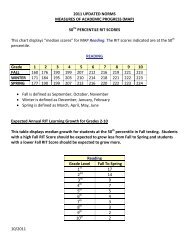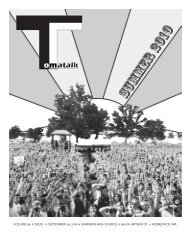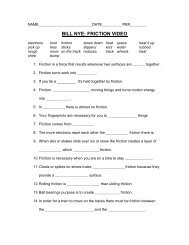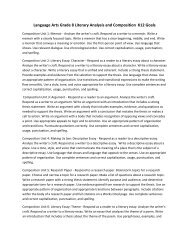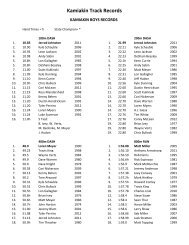Circular Motion; Gravitation
Circular Motion; Gravitation
Circular Motion; Gravitation
You also want an ePaper? Increase the reach of your titles
YUMPU automatically turns print PDFs into web optimized ePapers that Google loves.
<strong>Circular</strong> <strong>Motion</strong>;<br />
<strong>Gravitation</strong>
O<br />
O<br />
O<br />
Objectives<br />
Students should understand the uniform circular motion of a particle, so they<br />
can:<br />
O Relate the radius of the circle and the speed or rate of revolution of the<br />
particle to the magnitude of the centripetal acceleration.<br />
O Describe the direction of the particle’s velocity and acceleration at any<br />
instant during the motion.<br />
O Determine the components of the velocity and acceleration vectors at any<br />
instant, and sketch or identify graphs of these quantities.<br />
Students should know Newton’s Law of Universal <strong>Gravitation</strong>, so they can:<br />
O Determine the force that one spherically symmetrical mass exerts on<br />
another.<br />
O Determine the strength of the gravitational field at a specified point outside<br />
a spherically symmetrical mass.<br />
Students should understand the motion of an object in orbit under the<br />
influence of gravitational forces, so they can:<br />
O Recognize that the motion does not depend on the object’s mass; describe<br />
qualitatively how the velocity, period of revolution, and centripetal<br />
acceleration depend upon the radius of the orbit; and derive expressions<br />
for the velocity and period of revolution in such an orbit.<br />
O Derive Kepler’s Third Law for the case of circular orbits.
5-1: Kinematics of Uniform <strong>Circular</strong> <strong>Motion</strong><br />
O Uniform circular motion describes the movement of an<br />
object in a circular path at a constant speed, v, but at a<br />
constantly changing velocity vector, v, necessary for the<br />
object to stay on the path.<br />
O The velocity vector at a given point in the path is the<br />
tangent to the circular path in the direction of motion.
O The acceleration corresponding to this changing<br />
velocity at a given point is directed toward the center of<br />
the circle, and it is called centripetal or radial<br />
acceleration. Radial acceleration is proportional to the<br />
square of the velocity and inversely proportional to the<br />
radius,<br />
O At a point in the path, the velocity and acceleration of<br />
an object undergoing uniform circular motion are<br />
perpendicular
O The number of revolutions per second by the object is<br />
denoted by the frequency, f. The time in seconds for<br />
each revolution, T, is its reciprocal, T = 1/f, and is<br />
called the period.<br />
O From these definitions, an equation for the speed can<br />
be derived, v = 2πr/T.
Example 5-1: Acceleration of a revolving ball<br />
O A 150-g ball at the end of a string is revolving uniformly<br />
in a horizontal circle of radius 0.600 m. The ball makes<br />
2.00 revolutions in a second. What is its centripetal<br />
acceleration?
Exercise A<br />
O If the string is doubled in length to 1.20 m but all else<br />
stays the same, by what factor will the centripetal<br />
acceleration change?
Example 5-2: Moon’s centripetal acceleration<br />
O The Moon’s nearly circular orbit about the Earth has a<br />
radius of about 384,000 km and a period T of 27.3 days.<br />
Determine the acceleration of the Moon toward the<br />
Earth.
5-2: Dynamics of Uniform <strong>Circular</strong> <strong>Motion</strong><br />
O The force required to keep an object in uniform circular<br />
motion is directed inward toward the center and is the<br />
product of mass and radial acceleration,<br />
O There is no centrifugal force pointing outward; what<br />
happens is that the natural tendency of the object to<br />
move in a straight line must be overcome.<br />
O If the centripetal force vanishes, the object flies off<br />
tangent to the circle.
O Often the force is provided by the tension of a rope or<br />
string.<br />
O Automobiles require friction between the wheels and<br />
the road to provide the inward force necessary for<br />
moving in a circle, or more often, in an arc of a circle.<br />
O Satellites use gravity to provide the centripetal force for<br />
circular obits.
Example 5-3: Force on revolving ball<br />
(horizontal)<br />
O Estimate the force a person must exert on a string<br />
attached to a 0.150-kg ball to make the ball revolve in a<br />
horizontal circle of radius 0.600 m. The ball makes<br />
2.00 revolutions per second (T=0.500 s), as in Example<br />
5-1.
Example 5-4: Revolving ball (vertical circle)<br />
O A 0.150-kg ball on the end of a 1.10-m-long cord<br />
(negligible mass) is swung in a vertical circle.<br />
O (a) Determine the minimum speed the ball must have at<br />
the top of its arc so that the ball continues moving in a<br />
circle.<br />
O (b) Calculate the tension in the cord at the bottom of the<br />
arc, assuming the ball is moving at twice the speed of<br />
part (a)
Exercise B<br />
O In a tumble dryer, the speed of the drum should be just<br />
large enough so that the clothes are carried nearly to<br />
the top of the drum and then fall away, rather than<br />
being pressed against the drum for the whole<br />
revolution. Determine whether this speed will be<br />
different for heavier wet clothes than for lighter dry<br />
clothes.
Exercise C<br />
O A rider on a Ferris wheel moves in a vertical circle of<br />
radius r at constant speed v. Is the normal force that<br />
the seat exerts on the rider at the top of the wheel (a)<br />
less than, (b) more than, or (c) the same as, the force<br />
the seat exerts at the bottom of the wheel?
Conceptual Example 5-5: Tetherball<br />
O The game of tetherball is played with a ball tied to a pole<br />
with a string. After the ball is struck, it revolves around<br />
the pole. In what direction is the acceleration of the ball,<br />
and what force causes the acceleration?
Problem Solving: Uniform <strong>Circular</strong> <strong>Motion</strong><br />
1. Draw a free-body diagram<br />
2. Determine the forces or components of forces that act<br />
radially<br />
3. Choose a convenient coordinate system<br />
4. Apply Newton’s second law to the radial components
5-3: Highway Curves,<br />
Banked and Unbanked<br />
O When a car goes around a curve, there must be a net<br />
force towards the center of the circle of which the curve<br />
is an arc. If the road is flat, that force is supplied by<br />
friction.<br />
O If the frictional force is insufficient, the car will tend to<br />
move more nearly in a straight line, as the skid marks<br />
show.
O As long as the tires do not slip, the friction is static. If<br />
the tires do start to slip, the friction is kinetic, which is<br />
bad in two ways:<br />
O The kinetic frictional force is smaller than the static.<br />
O The static frictional force can point towards the center of<br />
the circle, but the kinetic frictional force opposes the<br />
direction of motion, making it very difficult to regain<br />
control of the car and continue around the curve.
Example 5-6: Skidding on a curve<br />
O A 1,000-kg car rounds a curve on a flat road of radius<br />
50 m at a speed of 50 km/h (14 m/s). Will the car<br />
follow the curve, or will it skid? Assume:<br />
O (a) the pavement is dry and the coefficient of static<br />
friction is µ s = 0.60;<br />
O (b) the pavement is icy and µ s = 0.25
Example 5-7: Banking angle<br />
O (a) For a car traveling with speed v around a curve of<br />
radius r, determine a formula for the angle at which a<br />
road should be banked so that no friction is required.<br />
O (b) What is this angle for an expressway off-ramp curve<br />
of radius 50 m at a design speed of 50 km/h?
Exercise D<br />
O To negotiate an unbanked curve at a faster speed, a<br />
driver puts a couple of sand bags in his van aiming to<br />
increase the force of friction between the tires and the<br />
road. Will the sand bags help?
Exercise E<br />
O Can a heavy truck and a small car travel safely at the<br />
same speed around an icy, banked-curve road?
5-4: Nonuniform <strong>Circular</strong> <strong>Motion</strong><br />
O If an object is moving in a circular<br />
path but at varying speeds, it must<br />
have a tangential component to its<br />
acceleration as well as the radial one.<br />
O This concept can be used for an<br />
object moving along any curved path,<br />
as a small segment of the path will be<br />
approximately circular.
Example 5-8: Two components of acceleration<br />
O A race car starts from rest in the pit area and<br />
accelerates at a uniform rate to a speed of 35 m/s in<br />
11 s, moving on a circular track of radius 500 m.<br />
Assuming constant tangential acceleration, find<br />
O (a) the tangential acceleration, and<br />
O (b) the radial acceleration, at the instant when the speed<br />
is v = 15 m/s.
Exercise F<br />
O When the speed of the race car in Example 5-8 is<br />
30 m/s, how are (a) a tan and (b) a R changed?
5-5: Centrifugation<br />
O A centrifuge works by spinning very fast. This means<br />
there must be a very large centripetal force. The object<br />
at A would go in a straight line but for this force; as it is,<br />
it winds up at B.
Example 5-9: Ultracentrifuge<br />
O The rotor of an ultracentrifuge rotates at 50,000 rpm<br />
(revolutions per minute). The top of a 4.00-cm-long test<br />
tube is 6.00 cm from the rotation axis and is<br />
perpendicular to it. The bottom of the tube is 10.00 cm<br />
form the axis of rotation. Calculate the centripetal<br />
acceleration, in “g’s” at the top and bottom of the tube.
5-6: Newton’s Law of Universal <strong>Gravitation</strong><br />
O The gravitational force on you is one-half of a Third Law<br />
pair: the Earth exerts a downward force on you, and you<br />
exert an upward force on the Earth.<br />
O When there is such a disparity in masses, the reaction<br />
force is undetectable, but for bodies more equal in mass<br />
it can be significant.
O Newton’s law of universal gravitation states that for<br />
both masses, the magnitude of the attractive force<br />
between them is proportional to the product of the<br />
masses and inversely proportional to the square of<br />
distance.<br />
O<br />
where<br />
O The magnitude of the gravitational constant G can be<br />
measured in the laboratory. This is the Cavendish<br />
experiment.
Example 5-10: Can you attract another<br />
person gravitationally?<br />
O A 50-kg person and a 75-kg person are sitting on a<br />
bench. Estimate the magnitude of the gravitational<br />
force each exerts on the other.
Example 5-11: Spacecraft at 2r E<br />
O What is the force of gravity acting on a 2,000-kg<br />
spacecraft when it orbits two Earth radii from the<br />
Earth’s center (that is, a distance r E = 6380 km<br />
above the Earth’s surface)? The mass of the Earth<br />
is M E = 5.98 x 10 24 kg.
Example 5-12: Force on the Moon<br />
O Find the net force on the Moon (m M = 7.35 x 10 22 kg)<br />
due to the gravitational attraction of both the Earth<br />
(m E = 5.98 x 10 24 kg) and the Sun (m S = 1.99 x 10 30 kg),<br />
assuming they are at right angles to each other.
5-7: Gravity Near the Earth’s Surface;<br />
Geophysical Applications<br />
O Now we can relate the gravitational constant to the<br />
local acceleration of gravity. We know that, on the<br />
surface of the Earth:<br />
O Solving for g gives:<br />
O Now, knowing g and the radius of the Earth, the mass<br />
of the Earth can be calculated:
O The acceleration due to gravity varies over the Earth’s<br />
surface due to altitude, local geology, and the shape of<br />
the Earth, which is not quite spherical.
Example 5-13: Gravity on Everest<br />
O Estimate the effective value of g on the top of Mt.<br />
Everest, 8,850 m (29,035 ft) above sea level. That is,<br />
what is the acceleration due to gravity of objects<br />
allowed to fall freely at this altitude?
5-8: Satellites and “Weightlessness”<br />
O Satellites are routinely put<br />
into orbit around the Earth.<br />
The tangential speed must<br />
be high enough so that the<br />
satellite does not return to<br />
Earth, but not so high that<br />
it escapes Earth’s gravity<br />
altogether.<br />
O The satellite is kept in orbit<br />
by its speed – it is<br />
continually falling, but the<br />
Earth curves from<br />
underneath it.
O Objects in orbit are said to experience weightlessness.<br />
They do have a gravitational force acting on them,<br />
though!<br />
O The satellite and all its contents are in free fall, so there<br />
is no normal force. This is what leads to the experience<br />
of weightlessness.
O More properly, this effect is called apparent<br />
weightlessness, because the gravitational force still<br />
exists. It can be experienced on Earth as well, but only<br />
briefly:
Example 5-14: Geosynchronous satellite<br />
O A geosynchronous satellite is one that stays above the<br />
same point on the Earth, which is possible only if it is<br />
above a point on the equator. Such satellites are used<br />
for TV and radio transmission, for weather forecasting,<br />
and as communication relays. Determine<br />
O (a) the height above the Earth’s surface such a satellite<br />
must orbit, and<br />
O (b) such a satellite’s speed.<br />
O (c) Compare to the speed of a satellite orbiting 200 km<br />
above Earth’s surface.
Exercise G<br />
O Two satellites orbit the Earth in circular orbits of the<br />
same radius. One satellite is twice as massive as the<br />
other. Which of the following statements is true about<br />
the speeds of these satellites? (a) The heavier satellite<br />
moves twice as fast as the lighter one. (b) The two<br />
satellites have the same speed. (c) The lighter satellite<br />
moves twice as fast as the heavier one. (d) The heavier<br />
satellite moves four times as fast as the lighter one.
5-9: Kepler’s Laws and Newton’s Synthesis<br />
O Kepler’s laws describe planetary motion.<br />
O Kepler’s first law states that planetary pathways are<br />
elliptical, orbiting around the Sun, which is at one focus<br />
of the ellipse.
O Kepler’s second law states that an imaginary line from<br />
the sun to the planet sweeps out equal areas in equal<br />
periods of time.<br />
O Kepler’s third law states that the ratio of the cube of a<br />
planet’s mean distance from the Sun to the square of<br />
its period is constant for all planets.
Example 5-15: Where is Mars?<br />
O Mars’ period (its “year”) was noted by Kepler to be about<br />
687 days (Earth days), which is (687 d/365 d) = 1.88 yr.<br />
Determine the distance of Mars form the Sun using the<br />
Earth as a reference.
Example 5-16: The Sun’s mass determined<br />
O Determine the mass of the Sun given the Earth’s<br />
distance from the Sun as r ES = 1.5 x 10 11 m.


